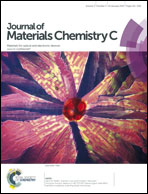Synthesis and characterization of a highly conductive organic–inorganic hybrid polymer electrolyte based on amine terminated triblock polyethers and its application in electrochromic devices†
Abstract
A new highly ion conductive organic–inorganic hybrid electrolyte based on the reaction of triblock co-polymer poly(propylene glycol)-block-poly(ethylene glycol)-block-poly(propylene glycol) bis(2-aminopropyl ether) (ED2003) with 3-(glycidyloxypropyl)trimethoxysilane (GLYMO) and followed by co-condensation with 2-methoxy(polyethyleneoxy)propyl trimethoxysilane (MPEOPS) in the presence of LiClO4 was synthesized by a sol–gel process and characterized by a variety of experimental techniques. The maximum ionic conductivities of 1.1 × 10−4 S cm−1 at 30 °C and 6.0 × 10−4 S cm−1 at 80 °C were obtained for the hybrid electrolyte with a [O]/[Li] ratio of 24. The conductivity mechanism changed from Arrhenius at lower temperatures to Vogel–Tamman–Fulcher (VTF) behavior at higher temperatures. The results of solid-state NMR confirmed the structural framework of the hybrids, and provided a microscopic view of the effects of salt concentrations on the dynamic behavior of the polymer chains. The electrochemical stability window was found to be around 3.7–4.5 V, which is sufficient for electrochemical device applications. Preliminary tests performed with prototype electrochromic devices (ECDs) comprising the hybrid electrolyte with various [O]/[Li] ratios and mesoporous WO3 as the cathode layer are extremely encouraging. The best performance device exhibits an optical density change of 0.58, coloration efficiency of 375 cm2 C−1 and a good cycle life with the hybrid electrolyte with a [O]/[Li] ratio of 24. The present hybrid electrolyte offers a remarkable ionic conductivity and coloration efficiency in the solid state than previously reported organic–inorganic hybrid electrolytes.


 Please wait while we load your content...
Please wait while we load your content...